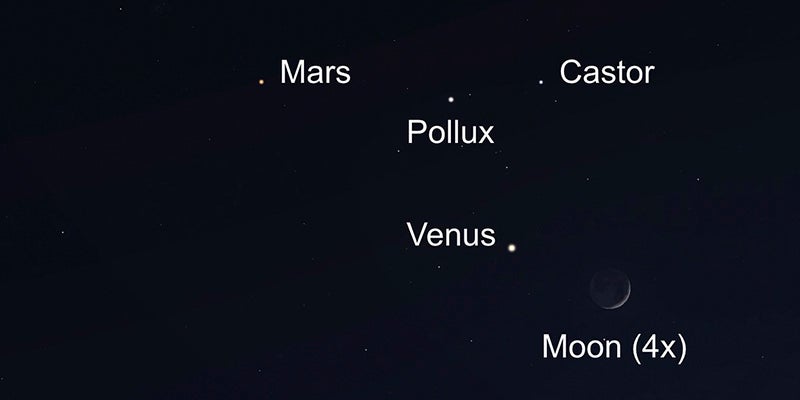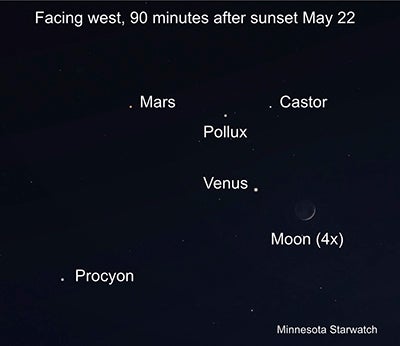Minnesota StarWatch: Venus continues bright in the skies
Published 5:56 pm Tuesday, April 25, 2023

- Graphic provided
|
Getting your Trinity Audio player ready...
|
By Deane Morrison
During May, brilliant Venus holds its own above the western horizon as the last of the bright winter stars stream past it.
Our sister planet begins the month by gliding between Betelgeuse, in Orion, and Capella, in Auriga, the charioteer. Betelgeuse, to the lower left of Venus, is outshone by both the planet and high, lustrous Capella. As these stars drop away, Venus passes through Gemini, all the while following a course toward Mars, which appears to be fleeing its approach.
 Mars starts the month below Pollux, the brighter of the Gemini twins. As Gemini sinks, Pollux glides past the red planet.
Mars starts the month below Pollux, the brighter of the Gemini twins. As Gemini sinks, Pollux glides past the red planet.
The assemblage is enhanced between Monday and Wednesday, the 22nd and 24th, when a waxing moon joins the stars and planets. The bright star passing to the lower left of Venus those nights is Procyon, in Canis Minor, the little dog. The moon appears next to Pollux on the 23rd and above Mars on the 24th.
The moon begins the month below the triangular hindquarters of Leo, the lion. Leo’s head — the backward question mark of stars known as the Sickle — now dips a bit as the constellation begins its inevitable descent into the sunset. On the 3rd, the moon shines just above Spica, the only bright star in Virgo, the maiden. Above them, radiant Arcturus anchors the kite-shaped constellation Bootes, the herdsman.
May’s full moon arrives at 12:34 p.m. on Friday, the 5th. The moon sets in the west shortly before sunrise that day, so your best bet may be to enjoy the moonrise on the evening of the 4th or 5th. Also in the predawn hour, a waning moon visits Saturn in the southeastern sky on Saturday, the 13th. On Wednesday, the 17th, a thin lunar crescent visits Jupiter very low in the east, in the midst of the sun’s foreglow.
The University of Minnesota offers public viewings of the night sky at its Duluth and Twin Cities campuses. For more information, see:
• Duluth, Marshall W. Alworth Planetarium: www.d.umn.edu/planet
• Twin Cities, Minnesota Institute for Astrophysics: www.astro.umn.edu/outreach/pubnight
• Check out astronomy programs, free telescope events, and planetarium shows at the
• University of Minnesota’s Bell Museum: www.bellmuseum.umn.edu/astronomy
•Find U of M astronomers and links to the world of astronomy at: http://www.astro.umn.edu


